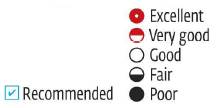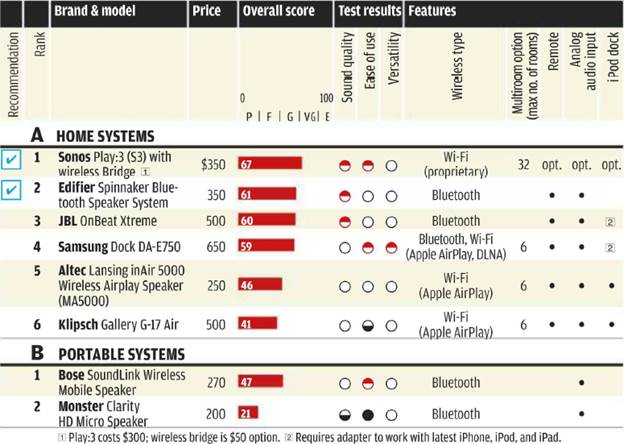Wireless speaker
systems let you play music stored on a phone, tablet, media player, or computer
that’s across the room or even elsewhere in the house. Our tests showed you
don’t’ have to trade sound quality for convenience. But these systems don’t’
come cheap-the tested models cost $200 to $650.

Wireless speaker systems let you play
music stored on a phone, tablet, media player, or computer that’s across the
room or even elsewhere in the house.
Most of the tested
models use Bluetooth, which works with a wide range of mobile devices,
including Android phones. Several use Apple’s AirPlay technology, which works
on Wi-Fi. Sonos uses Wi-Fi to create a network in which each device acts as a
repeater, extending the range. With some models, you might also get an iPod
dock or the ability to connect an iPod or iPhone via USB. All but one of the
systems have built-in auxiliary audio inputs for connecting other gear, such as
a TV.
Making setup easier


Ratings all tested models in performance
order, within types.

A1. Sonos Play:3 (S3) with Wireless
bridge
Give up
wires, not good sound.
A1 Sonos, A2 Edifier,
and A3 JBL deliver full, rich sound that carnival home-theater-in-a-box and
sound-bar speaker systems. All but one of the other models were good. With A1,
when we added a second Play:3 for a two-speaker stereo setup, sound quality was
excellent.

A2. Edifier Spinnaker Blue-tooth
Speaker System
Some are
very easy to use.
In general, Bluetooth
models were a bit easier to set up, because pairing took fewer steps than
connecting via Wi-Fi. A1 Sonos, A4 Samsung, and B1 Bose were the easiest to sue
overall. B2 Monster connected easily, but the controls on the console were
poorly marked and voice commands were annoying. A6 Klipsch had an easy-to-use
remote but took a hit for missing key setup steps in its user manual and for
poorly marked controls.

A4. Samsung Dock DA-E750
They can
be stylish.
Several models are
plain and boxy, but others sport striking designs-none more so than the
sail-shaped A2 Edifier Spinnaker. A3 JBL has a unique X-shaped design. B1
Bose’s integrated stand doubles as a fold-over cover for traveling. Whether
perched atop its glass stand or wall mounted, A6 Klipsch resembles a stylish
sound-bar. And you’ll find a pair of vacuum tubes glowing beneath a clear
circular window cut into the cherry-wood finish on the top of A4 Samsung.

A3. JBL Onbeat Xtreme
Features
vary.
A1 Sonos can
wirelessly stream songs from dozens of online music services. You can stream
audio to up to 32 Sonos speaker setups in different rooms. A2 Edifier has an
optical digital audio input for connecting other gear, plus an output for
adding a subwoofer. A3 JBL’s iPod/iPhone/iPad docking arm rotates form portrait
to landscape view, handy for watching video. It has a composite-video output
for sending video to a TV and a speaker-phone function. A4 Samsung’s
retractable “dual” dock works with iPhones, iPads, and iPods with the original
30-pin connector, and Samsung’s own Galaxy S II and III Android smart phones
and its Galaxy Note tablet/phone. B1 Bose can remember up to six Bluetooth
devices. B2 Monster, the smallest, responds to voice commands and works as a
speaker phone.

B2. Monster Clarity HD micro Speaker
Bluetooth vs. Wi-Fi
Bluetooth is supported
by many portable devices, including Android phones and tablets. But you can
stream to just one at a time, within a 30-foot range. Apple AirPlay uses Wi-Fi
and has a longer range. You can stream form an iPod, iPhone, or iPad to one
speaker, but a computer running iTunes can feed up to six speakers on the same
network. AirPlay is Apple-centric; you’ll need special apps to make it work
with an Android device. Sonos’ network can stream music to as many as 32
rooms.